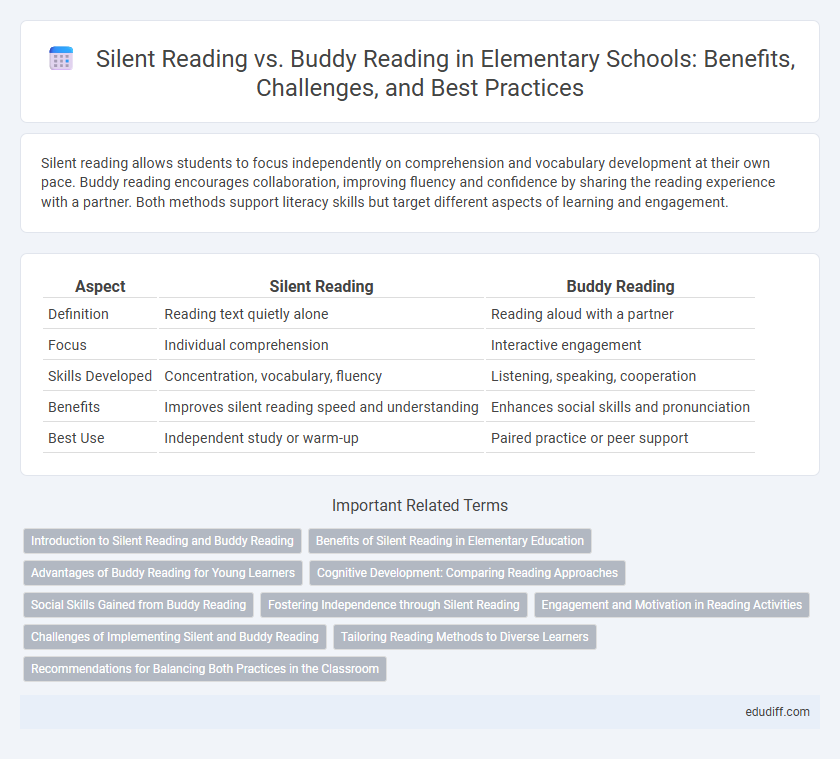Silent reading allows students to focus independently on comprehension and vocabulary development at their own pace. Buddy reading encourages collaboration, improving fluency and confidence by sharing the reading experience with a partner. Both methods support literacy skills but target different aspects of learning and engagement.
Table of Comparison
| Aspect | Silent Reading | Buddy Reading |
|---|---|---|
| Definition | Reading text quietly alone | Reading aloud with a partner |
| Focus | Individual comprehension | Interactive engagement |
| Skills Developed | Concentration, vocabulary, fluency | Listening, speaking, cooperation |
| Benefits | Improves silent reading speed and understanding | Enhances social skills and pronunciation |
| Best Use | Independent study or warm-up | Paired practice or peer support |
Introduction to Silent Reading and Buddy Reading
Silent reading enhances individual comprehension and fluency by allowing students to process text at their own pace, fostering internalization of vocabulary and sentence structure. Buddy reading promotes interactive learning through peer collaboration, encouraging discussion and immediate feedback that strengthen reading skills and social development. Both methods introduce foundational literacy skills, supporting varied learning preferences in elementary education.
Benefits of Silent Reading in Elementary Education
Silent reading in elementary education enhances students' ability to develop concentration and comprehension skills independently, fostering a deeper engagement with texts. This practice allows children to build vocabulary and improve decoding abilities at their own pace, which supports literacy growth. Research shows that consistent silent reading sessions contribute to higher reading fluency and academic achievement in young learners.
Advantages of Buddy Reading for Young Learners
Buddy reading enhances young learners' reading skills by promoting social interaction and collaborative learning, which helps improve comprehension and fluency. Sharing the reading experience increases engagement and motivation, making it easier for children to develop confidence in their abilities. This interactive method also provides immediate feedback and support, fostering a positive attitude toward reading.
Cognitive Development: Comparing Reading Approaches
Silent reading enhances individual comprehension and concentration by allowing students to process information at their own pace, which strengthens internal cognitive skills like memory and inference. Buddy reading promotes social interaction and verbal expression, helping children develop language skills, critical thinking, and empathy through discussion and collaboration. Both methods contribute to cognitive development but emphasize different aspects: silent reading fosters independent analysis, while buddy reading supports interactive learning and communication.
Social Skills Gained from Buddy Reading
Buddy reading enhances elementary students' social skills by promoting communication, cooperation, and empathy through shared reading experiences. It encourages active listening and turn-taking, which are crucial for effective interpersonal interactions. These collaborative skills support academic growth and build stronger peer relationships compared to silent reading.
Fostering Independence through Silent Reading
Silent reading enables elementary students to develop independence by allowing them to engage with texts at their own pace and build comprehension skills without immediate peer influence. This practice cultivates self-motivation and confidence as students internalize language patterns and deepen their understanding through personal reflection. Promoting silent reading in classrooms supports long-term literacy growth by fostering autonomous learning habits essential for academic success.
Engagement and Motivation in Reading Activities
Silent reading boosts individual engagement by allowing elementary students to focus on personal comprehension at their own pace. Buddy reading enhances motivation through social interaction, encouraging students to discuss stories and share insights. Combining both methods supports diverse learning preferences, promoting sustained interest and deeper understanding in reading activities.
Challenges of Implementing Silent and Buddy Reading
Silent reading can be challenging for elementary students due to limited vocabulary and difficulty maintaining focus, often requiring scaffolding and engagement strategies. Buddy reading faces obstacles such as mismatched reading levels, social distractions, and uneven participation, which can affect the effectiveness of peer learning. Teachers must address these issues by carefully pairing students and providing clear guidelines to ensure both methods foster comprehension and fluency.
Tailoring Reading Methods to Diverse Learners
Silent reading supports independent comprehension development by allowing elementary students to process text at their own pace, enhancing personalized learning experiences. Buddy reading encourages collaboration and oral language skills, benefiting learners who thrive in interactive environments and need social motivation. Tailoring reading methods involves assessing individual student needs, combining silent and buddy reading to optimize engagement and literacy growth across diverse learning styles.
Recommendations for Balancing Both Practices in the Classroom
Balancing silent reading and buddy reading in elementary classrooms enhances literacy development by catering to diverse learning styles and promoting both independent comprehension and collaborative skills. Teachers are encouraged to allocate specific times for silent reading to build concentration and fluency, while incorporating buddy reading sessions to foster social interaction and peer support. Optimizing this balance boosts student engagement and strengthens reading proficiency across varied skill levels.
Silent Reading vs Buddy Reading Infographic

 edudiff.com
edudiff.com